Santiago de Compostela to Negreira – 13.2 miles
We set out in the growing light of dawn, starting where we left off at the end of our Portuguese Camino – in front of St. James Cathedral at the scallop shell carved into the middle of the Plaza de Obradoiro- the end point of this and all other Caminos. Except for one. The exception is the Camino Finisterre, the only Camino to start from, not finish at, the Cathedral at Santiago de Compostela, and the one on which we were about to embark.
 |
| Getting ready for the final phase of our walk. |
 |
| Turn left at the Cathedral and don't stop until you get to the ocean. |
We turned left at the Cathedral and started our walk to the “end of the earth” which is the loose translation from the Latin “finis terre.” St. James was sent to the end of the earth, or what at the time was believed to be the end of the earth, to preach Christ’s teachings. His body, after being martyred back in the Holy Land, was brought back to the area in which he preached and eventually buried beneath what is now St. James Cathedral.
Our Camino would travel through those regions where St. James preached between Santiago de Compostela and Finisterre at the Atlantic Coast. We hope to reach the Atlantic Ocean on the day of MaryKay’s milestone 60th birthday, something she sought after to make such a birthday more memorable than those of the normal, run-of-the-mill variety.
But our start of this leg of the journey was marred with the heavy head cold MK was suffering from. Her energy levels were at their lowest. But, ever the trooper, she gutted it out, got out from under the covers of our very comfy bed, and set out with me and the other pilgrims heading to Finisterre.
We walked through the west side of town through the work-a-day world of Santiago’s residents. Parents were dropping off their kids at school. Drivers honked their horns at those who hadn’t noticed the light had turned green. The clatter of opening screens and gates were heard as merchants opened their storefronts. Workers walked out of their bakeries with large baskets of freshly baked baguettes and pastries to be delivered to area panaderias. I smelled them before I saw them. The modernity of all of this, and more, was incongruously interspersed among Santiago’s narrow lanes, cobblestoned streets, and ancient buildings originally designed and constructed back in the Middle Ages.
 |
| Last glimpses of Santiago and the Cathedral. |
At the town’s western edge, we began a steep, 800-foot climb along a two-mile forested stretch of trail. I was worried how MK would fare given her illness. But she kept her head down with a good, consistent pace.
 |
| Steep grades ahead. |
I left her alone with her thoughts, knowing that doing so would be better than if I were to blabber and yammer away like I usually do. No one wants to hear that when they are sick and just want to be left alone.
I instead focused on those climbing the trail with us. A Frenchman and his wife were burdened with an unusual amount of baggage, each with a large backpack and he also with a fully-loaded two-wheel cart attached to his waist with a belted harness. Two ladies, one a grayish blond, the other with cherry red hair, stopped along the way to pry open and then eat the chestnuts lying on the ground. We have been seeing them everywhere on our journey, today being no exception, as the nuts yet again cracked and crunched underfoot.
Further along, two men wearing skull caps passed us. They were carrying backpacks covered in various Camino patches. It appears they have walked just about all of Europe’s Caminos given the number of patches I saw. An elderly couple were speaking what I thought was English when I later walked up from behind them. I asked about what looked like unique walking sticks attached to her backpack. She seemed proud of them and began to describe, in a language I could not understand or discern, what were apparently prized possessions. I smiled and nodded as I walked past, pretending to understand what she was saying but, in truth, hadn’t a clue.
A café miraculously appeared at the top of our ascent. This called for some refreshments and an opportunity for lunch. I presented my credit card to the owner after placing my order. He shook his head no, pointing to the sign on the wall that I presumed said that credit cards were not accepted. So, I instead offered a twenty Euro note and, again, he shook his head no, pointing instead to the ten Euro note in my other hand. That worked. He was happy and so was I as I walked out to the patio with my tray full of Coke, beer, and goodies.
 |
| Now this is my kind of hiking! |
We continued on throughout the afternoon. MK's stength ebbed and flowed (more often ebbing than flowing, she would later say). Regardless, we enjoyed the villages and sights along the way.
 |
| The Camino shell is everywhere! |
We reached Negreira after a long and tiresome 13 plus miles. MK was cashed and couldn’t wait for our albergue to appear amongst the town’s many lanes and streets. Once inside, she went straight to bed, fully clothed, for her day was done.
Negreira to Vilaserio – 8.6 miles
The sun had just risen when we began our early and chilly morning walk through town toward the trailhead. The lingering fog that settled in the valley overnight made for interesting views.
 |
| Mr. McBeevee (Some of you may get this reference. Drop me a line if you are one of them). |
As we have on previous mornings, we interrupted the village dogs from their early slumber as we passed them along the trail. There are those who roam freely. They are not aggressive although we are ready to defend ourselves with our walking sticks if necessary. The more aggressive dogs bark and growl insanely as we pass. But for the fences and chains that hold them back, their gnarled teeth and snapping jaws, all at an uncomfortable scrotum-level height, would be cause for great concern.

The sun, hot and strong, finally broke through the fog. At times it was brutal, more so as we walked along the edge of the tarmac road that slowly climbed and then peaked over the height of land.
 |
| These types of refreshment breaks can become a habit! |
Earlier in our trek, when we walked north from Porto, the sun was mostly to our backs for most of the day. Here, on the westerly heading Finisterre Camino, the sun shines down on our left sides. For me, this is most unfortunate in that it is on the left side of my face where I already have a disproportionate amount of age spots. In fact, I look worse than Mr. Burns from the Simpsons, and I’m not even that old yet.
At 65 years old, age is indeed advancing on me. And I don’t like it. Those who know me and who may be regular readers of this blog know I talk a lot about it. Often, I do so in a joking and self-deprecating manner (see above). Maybe that is how I cope with the inevitability of it all.
If I’m lucky, I only have about 20 more years left on this Earth. I think about how fast the past 20 years have gone by and dread the faster pace the next 20 will take. Such is a constant reminder to do all you can do – adventure, travel, family, friends, etc. – everything, with the time you have left. There are only a limited amount of tomorrows, so do what you can do today and don’t hold back.
Though it was our shortest mileage day of the whole trek, it felt like it lasted forever. Finally, shaded lanes led us to our night’s little village and our pension.
Vilaserio
to Olveiroa – 12.9 miles
We had a lovely stay and a good night’s sleep in our pension overnight. Added to our pleasure in the early morning was a group of Austrian girls, pilgrims like us, who softly sang songs as they laced up their boots and buckled their backpacks in the garden area. Their harmony, likely unintentional, was pitch perfect.
Their singing was interrupted by their giggles as they struggled with the lyrics of an ABBA song. Nearby, another pilgrim, she too lacing up her boots, began to sing the song for them. Soon, all of them heartily sang "Thank You for the Music" with flawless lyrics.
It was barely light when this occurred. We were all getting an early start for the 13-mile trek ahead. The fog and mist, which have become a daily occurrence each morning, hung low and heavy. The squawking of crows, heard but not seen, was the only interruption to the otherwise stillness and deep quiet of the forest that we walked through once outside of town.
Throughout our journey, finding our way has not been a problem, even today in the darkness of this forest. We simply follow the granite trailside markers as well as the yellow arrows on buildings, utility posts, and manhole covers. We may not speak the Spanish language well, but we do know the language of these signs. It is a language that we have come to know so well over the course of our trek. If ever in need to double check our location or our progress, we then resort to our phone apps and hard copy maps. In combinig the use of all of these tools, we have never been in danger of getting lost.
 |
| One of the inumerable directional markers |
 |
| A screen shot from our app showing our position relative to the trail. |
 |
| Map from one of our guidebooks. |
 |
| Map from a different guidebook. |
After many kilometers without seeing another soul, a large group of trekkers appeared as they approached us from the other direction. As they passed, a woman who was trailing the group stopped to tie her boots. I too stopped to re-tie mine and we had a little chat.
She was a part of a large 27-person group who were walking the Finisterre Camino in an “out-and-back” loop by returning to Santiago after reaching Finisterre and Muxia. She said that everything she does and everywhere she goes, she must do so as part of the group with little, if any, time to do her own thing. She said she was envious of us when we told her we were traveling independently.
While we have been a part of a group tours in the past, and likely will do so again in the future, traveling independently is the way we prefer it. To us, our travels are more authentic and real when we must interact with the locals on our own and not have a tour leader acting as our intermediary. Furthermore, going independently (scheduling and coordinating everything ourselves, along with other costs savings measures we regularly employ) ends up costing about 60 percent of the cost of the group travel method where a budget travel company coordinates and oversees everything on your behalf. The savings are even greater when compared to those costs with higher end travel companies.
We are simple in our needs. We are not “foodies.” Only on occasion do we seek out fabulous restaurants or quaint cafes in which to eat our meals when we travel. Instead, we are big fans of eating where the locals eat or, more often, shopping for our food from grocery stores and preparing our own meals using our hotel’s microwave and kettle in our room or our hostel's shared kitchen. Doing so is a cultural experience in and unto itself and the savings we realize both in cost and calories when we eat simply or if we prepare our own meals is significant.
We know our method is not for everyone. And that's okay. The comfort, security, and certainty of group travel has an appeal for a vast number of people. And tasting the cuisine of foreign lands in fancy restaurants is also a part of the experience many yearn for when traveling. But doing so comes at a cost. For us, it is a cost, both in terms of money and experiences, that is not worth it.
Back on the trail, the day wore on. The skies cleared. Villages were quiet. Farmers tilled their fields. Cows waited to be milked.
We ascended the heights to the region’s plateau. The views were endless.
We and other pilgrims have caught up to each other. We have conversations with several of them both on the trail and in a bar where we later had our lunch.
 |
| Okay, so I'm having yet another beer at lunch. You have a problem with that? |
 |
| Waiting for a free handout from our lunch offerings. |
 |
| We and fellow pilgrim crowd the cafe. |
One such pilgrim, an attractive twenty-something lady from the UK, chatted with us for a long while as we descended from the heights. We told her we recognized her from back in Santiago when she was part of a walking tour we had taken. MK noted her gorgeous hair then and told her now about how much she liked it. This got the conversation flowing: family, travels, where we started our trek, where we planned to finish, and many other topics. She told us she had been on a pilgrimage for the past 35 days while walking across Spain. MK then asked:
“So, what do you do for a living that allows you to take that kind of time off?”
Without hesitation, the young lady said, “I’m a sex worker and needed a break.”
Our jaws fell to the floor, or in this case, to the tarmac we were walking on.
Until then, I was only half-listening to the conversation. For reasons most men would understand, my interest had now piqued, I felt like asking more questions, such as “Did you earn your way across Spain,” or “Are you an independent contractor,” or maybe even a more probing question such as, “What kind of sex work do you do.”
As I was about to ask these questions, a quick look over to MK suggested that doing so would be one of the last things I’d ever do.
After a few more minutes of talking and walking, MK said, “Well, it was nice to meet you. We are going to move along.” And that, my friends, would be the closest I would ever get to knowing and chatting with a prostitute.
As we later walked up to our evening’s pension, I noted that our UK friend was continuing down the road. Sadly, she would not be staying where we were staying.
Olveiroa
to Corcubion – 12.4 miles
We and our fellow pilgrims were mostly quiet as we began our walk in the early morning fog. It seemed deeper and thicker than previous days. Interestingly, though, it also seemed to dissipate much sooner that the lighter stuff we’ve walked through previously.
 |
| Cycling pilgrims at "The Great Divide." |
 |
| "The Great Divde" marks a split in the trail. To the right is the route to Muxia. To the left, our direction, is the route to Finisterre. |
We were in a contemplative mood. As we near the end of our 200-mile trek, we went over in our minds the ups and downs of our experiences over these past many days.
The one thing that we will miss the most is the uncomplicated simplicity of our days: we wake up, have some breakfast, walk by 9 a.m., stop for a coffee and pastry around 10:30, walk, stop for lunch around 1230-100 p.m. (yes, sometimes with a beer), walk until around 3 or 4 o’clock, check into our hotel, shower, have dinner, and then hit the sack. The routine of it all, day after day, without interference or complication, is so appealing that you wonder if you could do this forever.
But then realism sets in and interrupts our reverie. Along with the good stuff comes the things that make you pause. Parts of your body you don’t normally think about have now joined us at center stage and have become a part of our daily routine. There are our joints (MK is now wearing a brace on her knee), the soles of my feet (I’ve been trying to keep my metatarsal pain at bay), lower back muscle spasms (yes, I’ve been having those too), assorted blisters (here and there for both of us), and blackened toenails from our feet jamming into the front of our boots (we both are suffering from this as well).
These will eventually heal upon our return home. But will we stay committed to our pledge to live more simply once there? If we can do it during our travels, can we do it during our daily lives back home? It all remains to be seen.
Eventually, we went back to concentrating on the trail before us. The sun was now shining brightly as we walked through endless miles of nothingness. But while passing through this remoteness and austerity, we were able to see what unique beauty lay within. Endless views along the open lands, deep green eucalyptus forests, and several stream crossings added to the charm and noteworthiness of our surroundings.
A couple of ancient chapels were but a few of the things that interrupted this long stretch of emptiness. At one, called the Lady of the Snows (we have one of these back in the U.S. near St. Louis), a women pilgrim solemnly walked up to its façade and began to sing “Ave Maria” in a sweet and earnest voice. MK and I were both taken by this. I would have this song in my mind for many of the trail miles to follow.
 |
| Our Lady of the Snows. |
 |
| A woman sings "Ave Maria" in front of the chapel. |
At the San Pedro Marti chapel, a well sprung forth cold and clear water. There is an annual festival that draws many locals here for it is believed that the waters will heal arthritis, joint pain, and other ailments. With nothing to lose, MK poured some of the waters over her aching knee.
The eucalyptus forests thrived here at these elevations. Workers were harvesting the trees but doing so in a clear-cut fashion. Being fast growers, this may not be cause for concern that one may otherwise have in forests of other slow-growing species. We learned that while eucalyptus trees are non-native and considered invasive, they do provide an important resource to the region’s paper producing industry.
Our westerly progress now turned south down the peninsula that would lead us to Finesterre. In the distance, we caught our first glimpses of the ocean. Likewise, at the far reaches of the horizon, we could see the Finisterre lighthouse that is our final destination.
 |
| The two white buildings at the far horizon (left center of the picture) are the Finisterre lighthouse, our final destination. |
These features came into greater focus the further south we trekked. Eventually, after a long descent that was hard on the kness and quads, we were walking sea-side toward our hotel after finally reaching the towns of Cee and Concubion.
Corcubion
to Cabo Finisterre – 9.1 miles
It has been ten months since MaryKay considered and then chose something that in her words would be an “epic” trip for her milestone 60th birthday. And now, in only a few more hours, we were about to conclude a 200-mile trek along the Caminos in Portugal and Spain, finishing at the Atlantic Ocean at Finisterre, the “End of the Earth.” A trip that has been indeed epic.
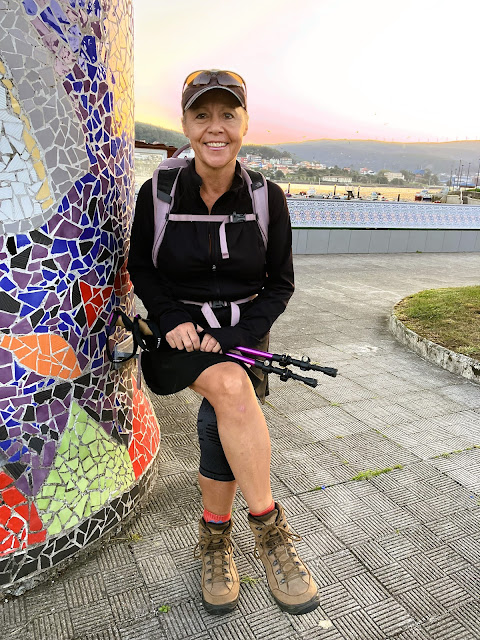 |
| Happy 60th birthday to my wonderful and adventurous wife! |
 |
| Still smiling after nearly 200 miles! |
We left town at our usual time, just after sunrise. Here, the ocean’s influences must have had an effect for there were no deep fog and mist to contend with. The path through town and then as it followed hillside contours through long stretches of coastline forest allowed for occasional peeks of the beaches and ocean below.
 |
| Getting close. The lighthouse is at the left edge of the far-off headland. |
In time, we were on those beaches, part of the Camino path toward Finisterre. You could tell it was off-season for the sands were largely deserted but for a handful of vacationers getting their last suntans of the season.
The path left the beach and began its long and slow climb to the lighthouse at Cabo Finisterre, our final destination. We had done plenty of long climbs throughout this trip. But this one seemed to be the hardest. Maybe it was because our bodies were finally saying "enough is enough" after so many of them and now know that this was the last one.
MK hobbled up the stairs at Santa Maria church, the last building before the final kilometers, to say a prayer of thanks for a safe and wondrous journey. Her knee continued to bother her and now her Achilles tendon was inflamed.
Pilgrims we have't seen before as well as those we have met during the past week were on this final leg with us. Many have come from futher away and for many more miles than us.
A women double-amputee, strapped to her wheelchair, pushed hard on the wheels, passing us as we made our ascent. A young man with a group of three others also passed us. For some reason, he thought it necessary to have a Frisbee and a rubber chicken attached to his backpack.
The Italian couple we met several days ago nodded their heads in recognition as they passed. An older gentleman we met at our pension three days ago acknowledged us with a hello. The lady who sang “Ave Maria” back at yesterday’s chapel was slowly making her way. As we passed, I told her that I enjoyed her singing and that that song remained in my head for many miles thereafter.
Tour buses ground their gears and belched suffocating exhaust as they trundled up the road adjacent to our path. They carried hordes of day-trippers who didn’t acknowledge us whatsoever. In fairness, though, they have no idea what we have been through. But that was okay. We didn't mind. Being with our fellow pilgrims for these final few steps was all the acknowledgement and affirmation we needed.
We dodged and weaved our way through the scores of tourists and parked cars as we neared the top. And then there it was. Kilometer “Zero” on the granite stone marker sat before us with the lighthouse nearby - the "End of the Earth." We had made it.
After 200 miles, we had no more miles to walk and no more energy to give. Our journey, our trek, our Camino - MK's epic trip - was finished, as planned, on the day of her 60th birthday.
.JPG)










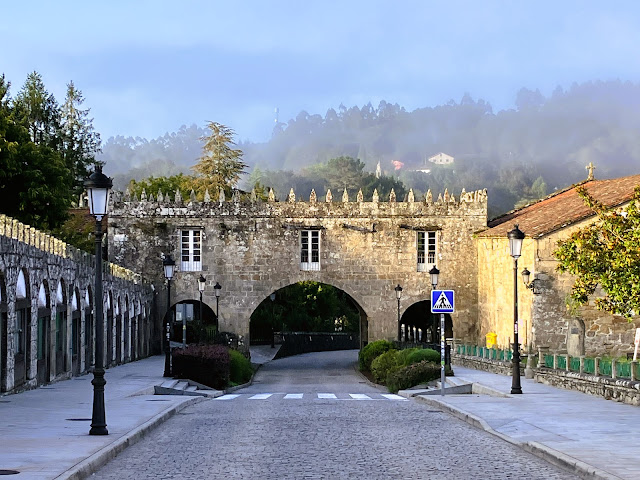




















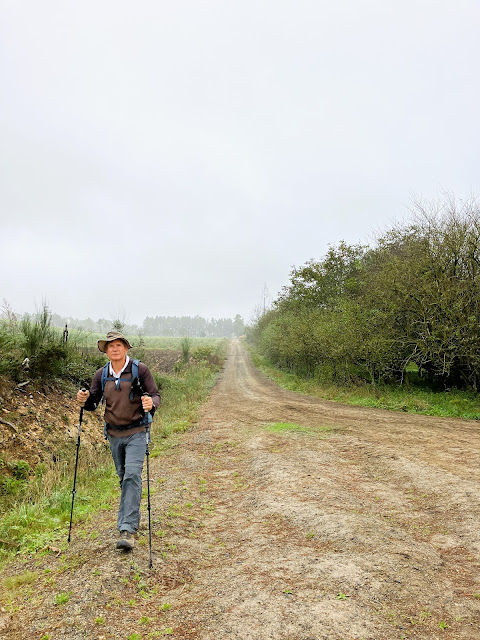







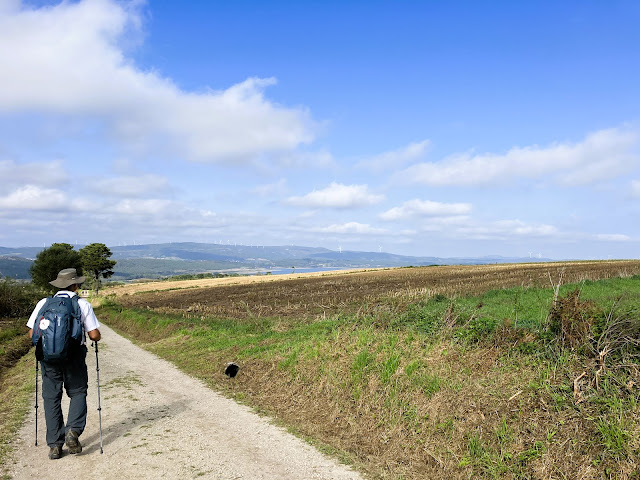





















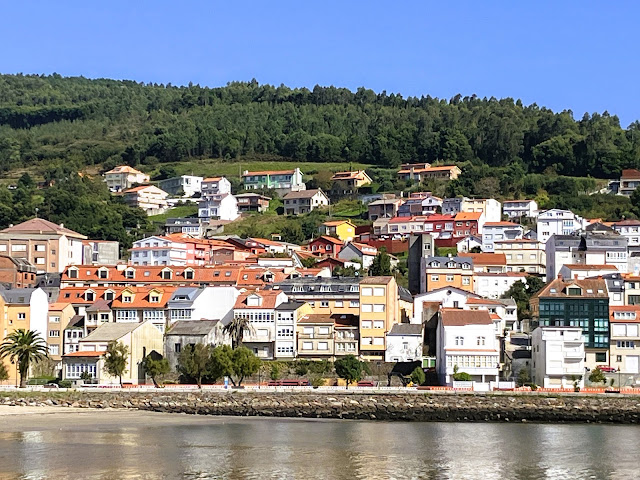





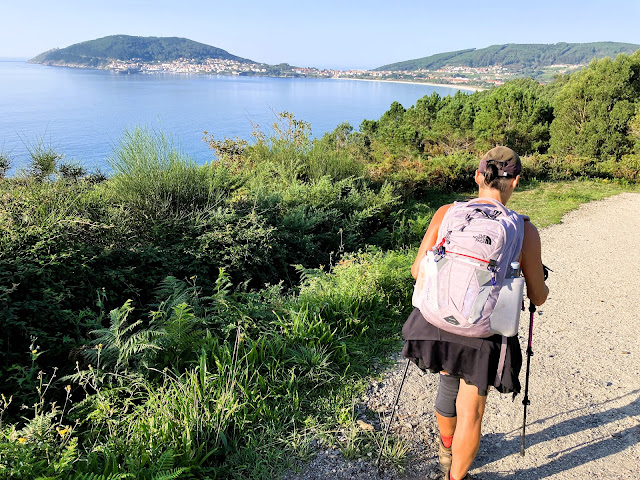










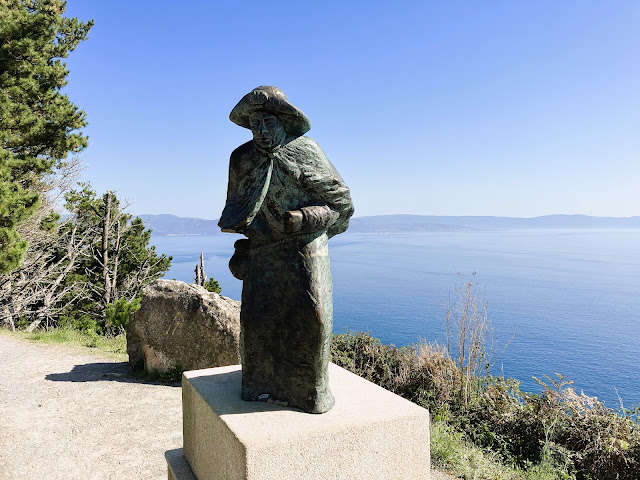









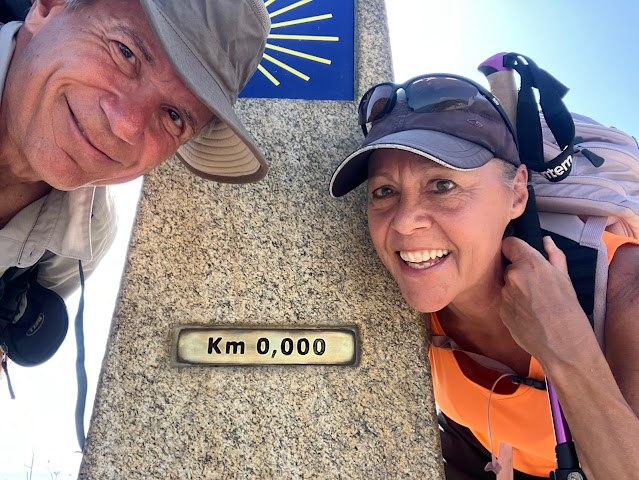

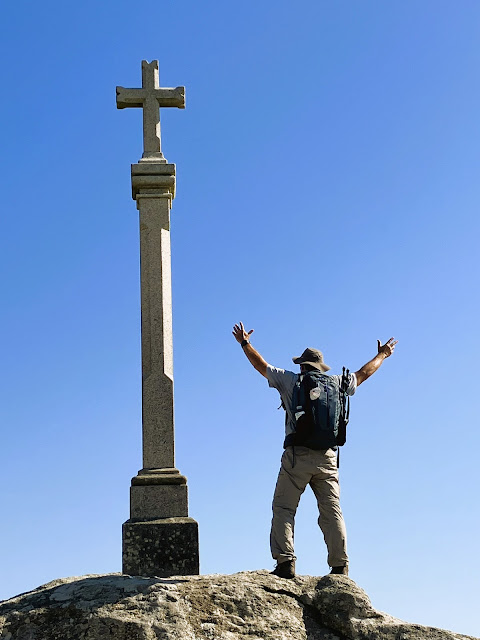

Comments
Post a Comment